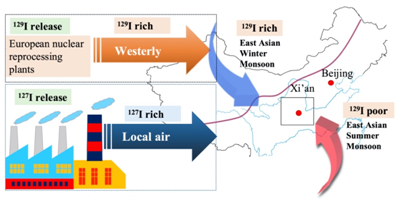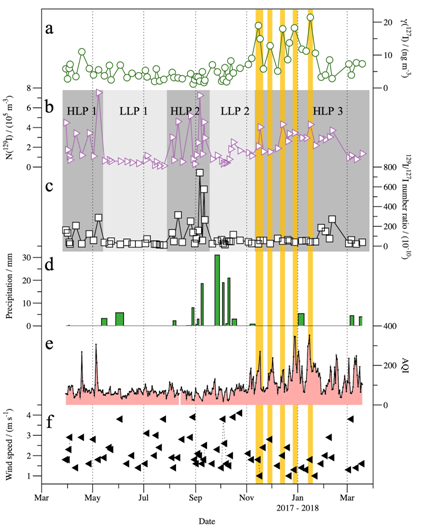Iodine-129 is a long-lived anthropogenic radioisotope of iodine, which is a fission product of nuclear fuel and mainly originates from human nuclear activities including atmospheric weapons testing, nuclear fuel reprocessing, and nuclear accidents.
Due to the volatile properties of iodine, high radiation risk of short-lived radioiodine, and long half-life of 129I, 129I is a key radionuclide for nuclear environmental safety monitoring and ideal tracer for investigation of environmental process such as dispersion, transport pathway of air pollution.
With the rapidly increased nuclear power plants in China and operation of nuclear fuel reprocessing plant, 129I might be also released from these facilities. While, the baseline of 129I in atmosphere in China and its present level and source is not well understood.
A research group from the Institute of Earth Environment of the Chinese Academy of Sciences analyzed day-resolution aerosols samples collected from Xi’an, China during 2017-2018 using ultra-sensitive accelerator mass spectrometry, and the first temporal variation of iodine-129 in the atmosphere in this region.
Significant fluctuations of iodine-127 and iodine-129 in the atmosphere with time were observed, showing their different sources. Aerosol 127I concentration in the atmosphere showed a positively correlation with air quality index and the level of five air pollutants, showed its artificial sources. Enhanced fossil fuel combustion in winter and relatively stagnant weather conditions contribute to the increased 127I level in winter.
The variation of the anthropogenic iodine-129 in atmosphere in Xi’an showed a pattern with low level in summer and high level in winter, with some exceptional high 129I signals in summer.
The European nuclear fuel reprocessing plant located at the westerly belt was the dominant contributor of 129I in the environment, the released 129I was transport to Asia by the westerly. The interaction of the 129I-contaminated westerly with the East Asian winter monsoon made it labeled with 129I, and blew from north to south in China, and reached to Xi’an. While, the East Asian summer monsoon from the west Pacific with low content of 129I level of global fallout blew to north and reach to Xi’an in summer.
The temporal variation of 129I in the atmosphere in Xi’an suggested that the level of 129I in Chinese monsoonal regions was alternatively dominated by the 129I-enriched East Asian winter monsoon or the 129I-poor East Asian summer monsoon. The high 129I signals occasionally occurred in summertime might be the break of the East Asian summer monsoon.
This work also suggested that locally released stable 127I and externally input 129I were likely involved into fine particles formation in urban air, shedding insights into long-range transport of air pollutants and iodine’s role in particulate formation in urban atmosphere.
This work also presented the first dataset of aerosol iodine-129 baseline of (92.7±124) ×10-10(expressed as the ratio of iodine-129 to iodine-127) in China. The temporal variation of the atmospheric baseline was related to metrological conditions, heavy haze events and atmospheric circulation, had to be carefully considered and used for better evaluation of the impact of possible nuclear incidents.
This work was supported by the National Natural Science Foundation of China, the Youth Innovation Promotion Association of CAS, the Ministry of Science and Technology basic project, and the National Research Program for Key Issues in Air Pollution Control project,etc.

Fig.1 Diagram showing the major sources of iodine isotopes and monsoonal influence on iodine-129(Imaged by ZHANG Luyuan, et al.)

Fig.2 Temporal variation of iodine-127 (a), iodine-129 (b) and 129I/127I number ratios (c) in aerosol samples collected in Xi’an, China from March 2017 to March 2018. The meteorological and air quality data includes precipitation (d), Air quality index (AQI, e) and wind speed (f). (Imaged by ZHANG Luyuan, et al.)
Contact: Bai Jie, Institute of Earth Environment, Chinese Academy of Sciences, Xi'an, China. Email: baijie@ieecas.cn
 © 2015 Institute of Earth Environment,CAS
© 2015 Institute of Earth Environment,CAS Address:No. 97 Yanxiang Road, Xi'an 710061, Shaanxi, China

 Location :
Location :